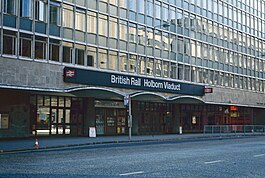Holborn Viaduct railway station
| Holborn Viaduct | |
|---|---|

Station entrance in August 1977
|
|
| Location | City of London |
| Owner | London, Chatham and Dover Railway |
| Number of platforms | 6 |
| Key dates | |
| 2 March 1874 | Opened |
| 29 January 1990 | Closed |
| Replaced by | St. Paul's Thameslink |
| Other information | |
| Lists of stations | |
|
|
|
Holborn Viaduct was a railway station in London which was opened in 1874 by the London, Chatham and Dover Railway as a new terminus to alleviate increasing usage of the nearby Ludgate Hill station.
The station became redundant with the creation of the Thameslink service in the late 1980s, and was closed in 1990 under British Rail, being effectively replaced by the nearby St. Paul's Thameslink station (later renamed City Thameslink).
During the 1860s and 1870s, Ludgate Hill had begun to struggle with increasing numbers of trains using the station. At the time, the London, Chatham and Dover Railway was suffering financial problems and was unable to raise capital to expand the station. A separate company was set up to construct a 330-yard (300 m) branch from the Ludgate Hill-Farringdon line that would terminate at a new station located on Holborn Viaduct, which would also have a new hotel forming its frontage.
Holborn Viaduct station opened on 2 March 1874 with the intention that it be used as a terminus for main line and continental trains: these services were intended to operate to both the City of London and the West End of London. Trains would travel as far as Herne Hill where they would split, with one portion going to Holborn Viaduct and the other to Victoria. Local services carried on through the Snow Hill Tunnel to join the Metropolitan Railway at Farringdon Street (now Farringdon), with a pair of low-level platforms just north of Holborn Viaduct to allow interchange with the main line services. Opened on 1 August 1874, these platforms formed a small station named Snow Hill, which was briefly renamed Holborn Viaduct Low Level in 1912.
...
Wikipedia
